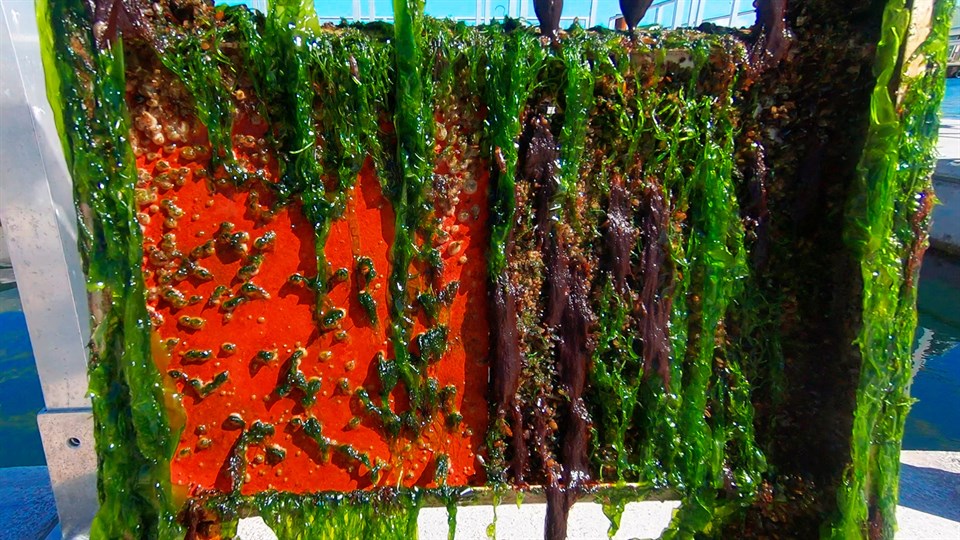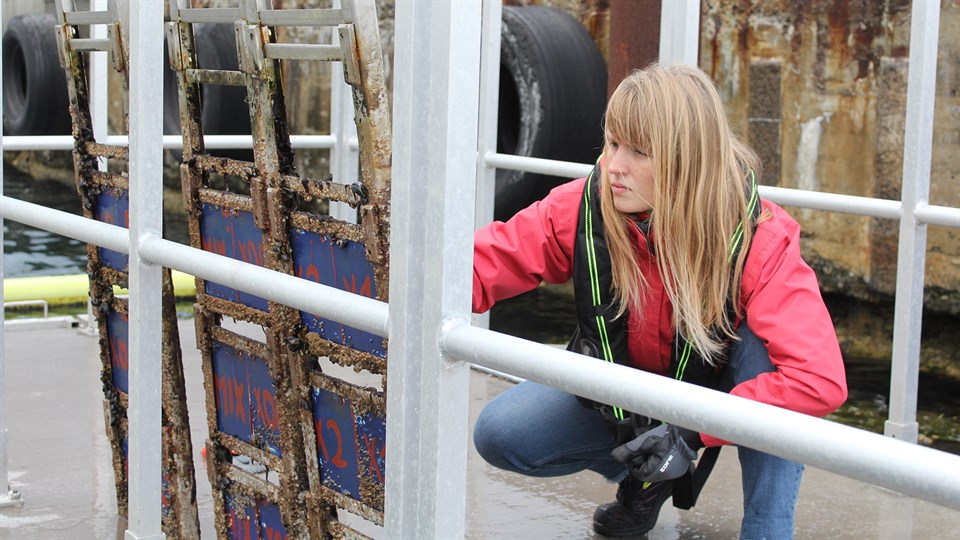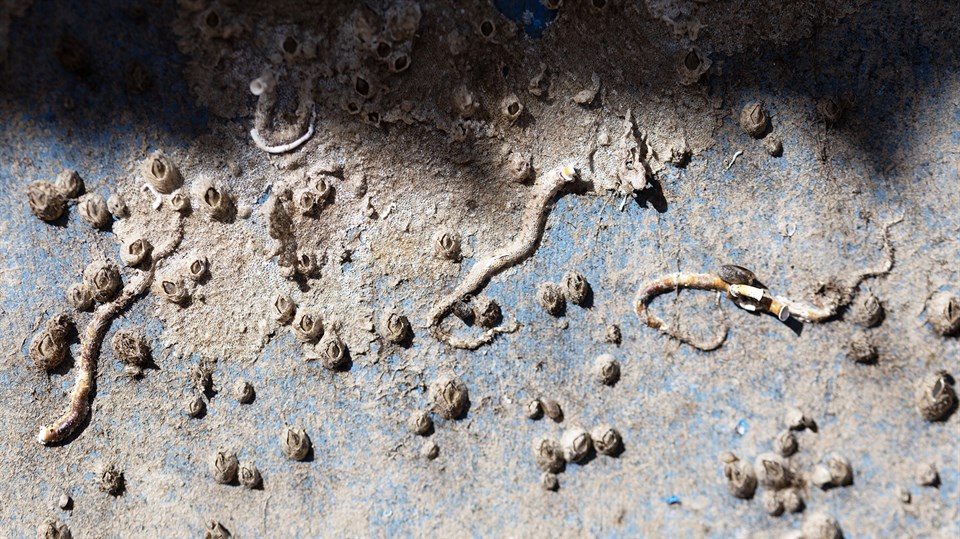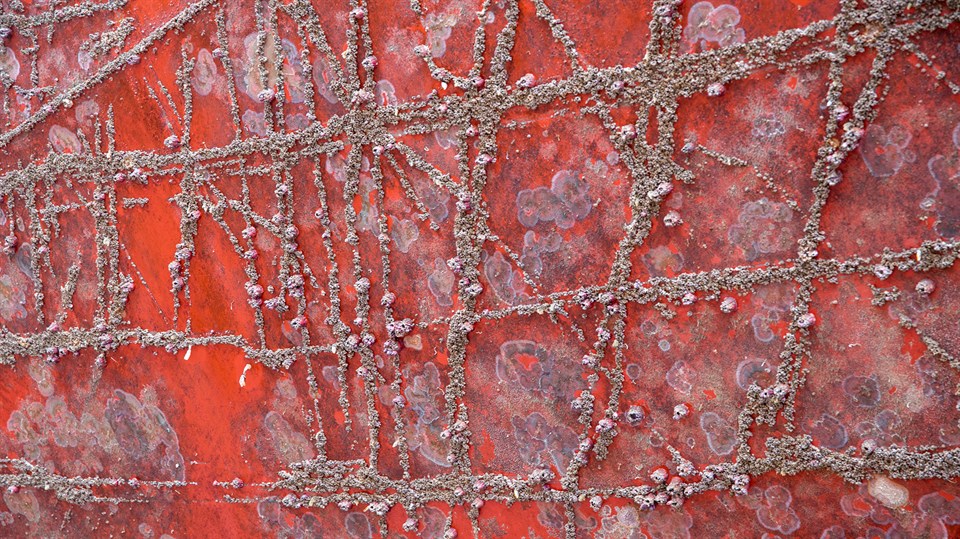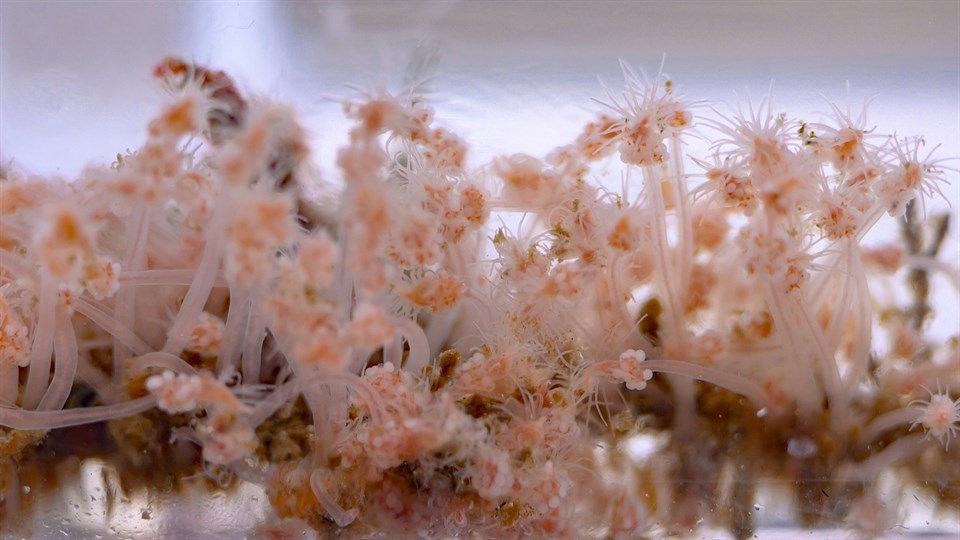Fouling control coatings
A living problem
Marine biofouling is the undesirable colonization of ship hulls and other underwater structures by microorganisms, seaweed and larger animals such as mussels and barnacles.
For fuel driven ships, the consequences of biofouling are:
- Higher fuel consumption and associated emissions of harmful compounds (SO2, NOx, and CO2).
- More frequent dry docking with high costs and generation of toxic waste
- Translocation of invasive species
A mechanical chemical solution
To combat biofouling, fouling control coatings are used. Generally, these are based on one of two principles:
- Chemically active coatings releasing biocides (conventional antifouling)
- Low energy and flexible coatings with no or very little biocide (fouling release)
The main challenge for conventional antifouling is to design a coating with adequate release rates of biocides. Too high a release rate is not sustainable, and a rate too low leads to biofouling. The requirement is a 3-5 years dry docking interval. At the same time, the antifouling coating should provide a smooth, low drag surface during the service period.
For fouling release coatings, the main challenge is to design a smooth coating that remains essentially fouling free without the use of biocides (or very low release rates) over the entire service period. In addition, the coatings should be mechanically strong to avoid formation of cracks and other defects.
Disciplines
The disciplines involved in analysing and understanding the working mechanisms of fouling control coating systems are mainly transport phenomena, colloid and surface science, analytical chemistry, mathematical modelling, polymer chemistry, advanced characterization tools, and ship hydrodynamics.
Projects
Summary
The technology of self-stratifying coatings offers a more sustainable alternative to conventional multilayer coating systems. Once a self-stratifying coating is applied on the substrate, the paint spontaneously separates into multiple coating layers.
Project
Present commercial fouling release coating systems comprise multiple layers, each of which is essential to ensure superior long-term anticorrosive, fouling control and interlayer adhesion properties of the whole system. The partial or even complete substitution of these coating layers with a well-designed self-stratifying coating would yield significant ecological and economic benefits.
The main research objectives are to formulate self-stratifying coatings including the exploration of applicable detection methods for self-stratification, to build a fundamental understanding of the processes being involved and to investigate the unique properties of self-stratifying coatings.
Field and laboratory tests with recurring coating formulation and application optimizations will be a key activity throughout the project. The performance of prototype self-stratifying coatings will be compared to state-of-the-art products.
Funding
Hempel Foundation and the Technical University of Denmark (DTU). The project runs from 15 November 2022 -15 November 2025
Supervisors
- Kim Dam-Johansen
- Søren Kiil
Contact
Luis Heller Student Students s221396@student.dtu.dk
Contact
Kim Dam-Johansen Professor, Head of Department Department of Chemical and Biochemical Engineering KDJ@kt.dtu.dk
Objective
- Study the effect of the cleaning forces and frequency of cleaning on the coatings integrity.
- Develop a novel automatic cleaning fouling-control coating and evaluate the coating performance in the laboratory, such as hardness, adhesion, roughness, surface energy, coating stability, etc..
- Complete Test-site testing and Demo-site testing with the most promising coatings from the lab testing to meet the real application
Background
The settlement and accumulation of biofouling on marine structures, such as ships, seawater intakes, heat exchangers and wind turbine towers, etc., results in adverse effects on their service performance, causes economic losses, maintenance and environmental damage. For biofouling management, fouling-control coatings and in-water cleaning are widely applied for the prevention of biofouling. Automatic in-water cleaning is powerful and efficient, however during cleaning, coating damage or wear or coating detachment from the substrate is normally not avoidable due to the force applied to detach the strongly attached marine species. Therefore, robust fouling-control coatings with low-settlement of marine biofoulants and sufficient mechanical stability are needed to complement the automatic in-water cleaning.
The project
This project aims to develop coatings with appropriate properties for under-water structures undergoing automatic cleaning, i.e. low-settlement of fouling and mechanically strong: hard coatings which can stand the mechanical force and have strong adhesion to the substrate.
Funding
China Scholarship Council (CSC), the Technical University of Denmark (DTU), and the Hempel Foundation. The project runs from 15 October 2020 - 14 October 2023.
Supervisors
- Kim Dam-Johansen
- Huichao (Teresa) Bi
Contact
Contact
Huichao (Teresa) Bi Associate Professor Department of Chemical and Biochemical Engineering Phone: +45 45252954 hubi@kt.dtu.dk
Objective
The objective of the project is to develop new and improved dynamic test systems for fouling control coatings. Dynamic exposure should assist in determining long-term performances, improved understanding of biofouling growth and coating selection for the specific operation.
Background
Static immersion have commonly been used to evaluate the performance of marine coating prior to application on ship hulls. The results obtained statically have provided well-established data, however, the hydrodynamic stress present on moving ships is neglected. Using dynamic testing will contribute to obtaining more realistic results, thus improving the development and evaluation of state of the art fouling control coatings.
The Project
Establish the next generation of dynamic test methods for fouling control coatings.
Increase the traditional output from dynamic test to high throughput by big sample capacity and extensive data monitoring on both conventional antifouling coatings and fouling release coatings.
Increase the reliability of data through obtaining additional datasets and more data points with a higher precision and accuracy. (Datasets: surface roughness, seawater temperature, salinity, rotational speed, cracking, polishing- and leaching rate, and biofouling growth etc. on several samples)
Funding
The Hempel Foundation and the Technical University of Denmark (DTU). The project runs from 1 May 2021 - 30 April 2024.
Supervisors
- Kim Dam-Johansen (main supervisor)
- Søren Kiil (co-supervisor)
Contact
Mads Olsen Student Students s153379@student.dtu.dk
Contact
Kim Dam-Johansen Professor, Head of Department Department of Chemical and Biochemical Engineering KDJ@kt.dtu.dk
Summary
Using a modern automated high throughput screening setup, incorporating machine learning for intelligent experiment design, the synergistic effects of catalysts for polyurethane systems are explored with the aim of diminishing the current reliance on toxic tin-based catalysts.
The Project
Currently, catalysis of polyurethane systems is heavily reliant on toxic tin-based catalysts. This reliance should be diminished for a more sustainable future, which can potentially be achieved through investigation of the synergistic effects of catalysts. However, many catalysts exist, making such an investigation a time consuming, labour intensive, and resource wasteful endeavor.
To address these problems, aid from chemistry 4.0 is drawn, which is the use of automation in combination with machine learning for the advancement of chemical knowledge. In this study, an automated high throughput screening setup, incorporating machine learning for intelligent experiment design is used. Utilization of such a setup, has two main benefits:
1. It ensures greater accuracy of experiments, as the human researcher is taken out of the equation.
2. The researcher is enabled to spend his/her focus on creative thinking, data interpretation, and finding new insights in literature.
However, despite its great potential, use of such setups is not yet widespread. Thus, the aim of this project is two-fold. One, improve the understanding of catalyst interactions in polyurethane systems, such that more informed/sustainable decisions can be made by coating manufacturers. Two, clearly demonstrate the advantages of chemistry 4.0 technologies, to strengthen the commitment of researchers and the industry and thus hopefully accelerate future scientific breakthroughs.
Funding
The Hempel Foundation and the Technical University of Denmark (DTU). The project runs from 1 December 2022 - 30 November 2025.
Supervisors
- Jochen Dreyer
- Kim Dam-Johansen
- Jost Göttert, Hochschule Niederrhein, Krefeldt (co-supervisor)
- Christian Schmitz, Hochschule Niederrhein, Krefeldt (co-supervisor)
Contact
Contact
Kim Dam-Johansen Professor, Head of Department Department of Chemical and Biochemical Engineering KDJ@kt.dtu.dk
Objective
Use inspiration from nature to find more sustainable and environmentally friendly solutions to marine bio-fouling challenges. Formulation of new coatings. Characterization of their mechanical properties in the lab and fouling protection under real exposure conditions on a fleet in the harbor of Hundested.
Background
Marine bio-fouling of ships and ocean infrastructures is problematic in an economical and safety point of view. However, many of the present technologies suffer from their durability, mechanical stability and environmental friendliness.
The project
The project focuses on technology inspired by bio-surfaces or natural biocides alone or in combination with other biocides, in order to lower the net environmental impact.
Funding
The Hempel Foundation and the Technical University of Denmark (DTU). The project runs from 1 November 2020- 31 January 2024.
Supervisors
- Kim Dam-Johansen (main supervisor)
- Markus Schackmann, University of Applied Sciences, Esslingen (co-supervisor)
Contact
Contact
Kim Dam-Johansen Professor, Head of Department Department of Chemical and Biochemical Engineering KDJ@kt.dtu.dk
The present project aims at designing a transparent, anti-fouling coating for use on solar cells and sensors on underwater drones or unmanned underwater vehicles (UUV). Overall, the goal of the coating is to maintain 80% UV and visible light transmission, while staying essentially free of seawater bio-fouling for at least three months of static immersion.
The main technical approaches involve formulating to proper application and film formation, following the transparency development during seawater immersion and evaluating the long term bio-fouling resistance in real seawater at sites in Denmark and USA.
To reach a prototype product in the two years available, coating formulation optimization will be an ongoing and recurring activity throughout the project. If successful for the present target application (transparency and bio-fouling resistance), the new coating formulation may be further developed to also ensure optical transparency, where close to 100 % light transmission is required.
Funding
Office of Naval Research (ONR) - US Navy. The project runs from 1 September 2021- 14 August 2024.
Supervisors
- Narayanan Rajagopalan
- Søren Kiil (PI)
Contact
Narayanan Rajagopalan Assistant Professor Department of Chemical and Biochemical Engineering naraj@kt.dtu.dk
Contact
Søren Kiil Professor Department of Chemical and Biochemical Engineering sk@kt.dtu.dk
Summary
Recent research suggests antifouling paints from ships are releasing harmful microplastics during sailing. The rate and manner of this release are largely unknown. This research aims to quantify and study the release of these antifouling paint particles in controlled lab experiments in order to provide support or possibly suggestions for mitigating the problem.
Project
Microplastics are a ubiquitous and persistant pollutant in the ocean. At high concentrations these micro sized plastic particles can have harmful impacts on ecosystems, marine life and carbon sequestration. To effectively reduce microplastic emissions, the main release pathways must be quantified and understood. This project aims to do this for the release of microplastics from fouling control coatings. These coatings are applied to the hulls of ships in order to prevent adhesion of biological species and reduce the drag resistance. Most of these coatings are antifouling coatings, which mainly consist of plastics and metal biocide particles. In order to understand the release of microplastics from fouling control coatings, a series of laboratory tests will be performed. These mainly consist of:
•Sailing simulations
•Particle analysis
•Material and surface analysis
From this, we will gain knowledge about the release rate and mechanisms of microplastics from antifouling coatings. This knowledge can be applied to evaluate existing and new products, as well as reduce these emissions in the future.
Funding
The Hempel Foundation and the Technical University of Denmark (DTU)
The project runs from 1 February 2023 to 1 February 2026
Supervisors
- Kim Dam-Johansen
- Søren Kiil
Contact
Matthias Bork PhD Student Department of Chemical and Biochemical Engineering merbo@kt.dtu.dk
Contact
Kim Dam-Johansen Professor, Head of Department Department of Chemical and Biochemical Engineering KDJ@kt.dtu.dk
